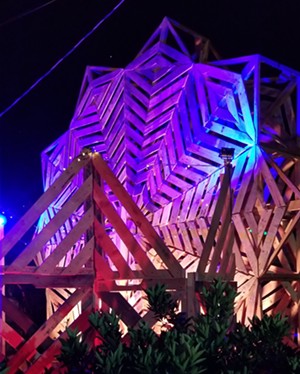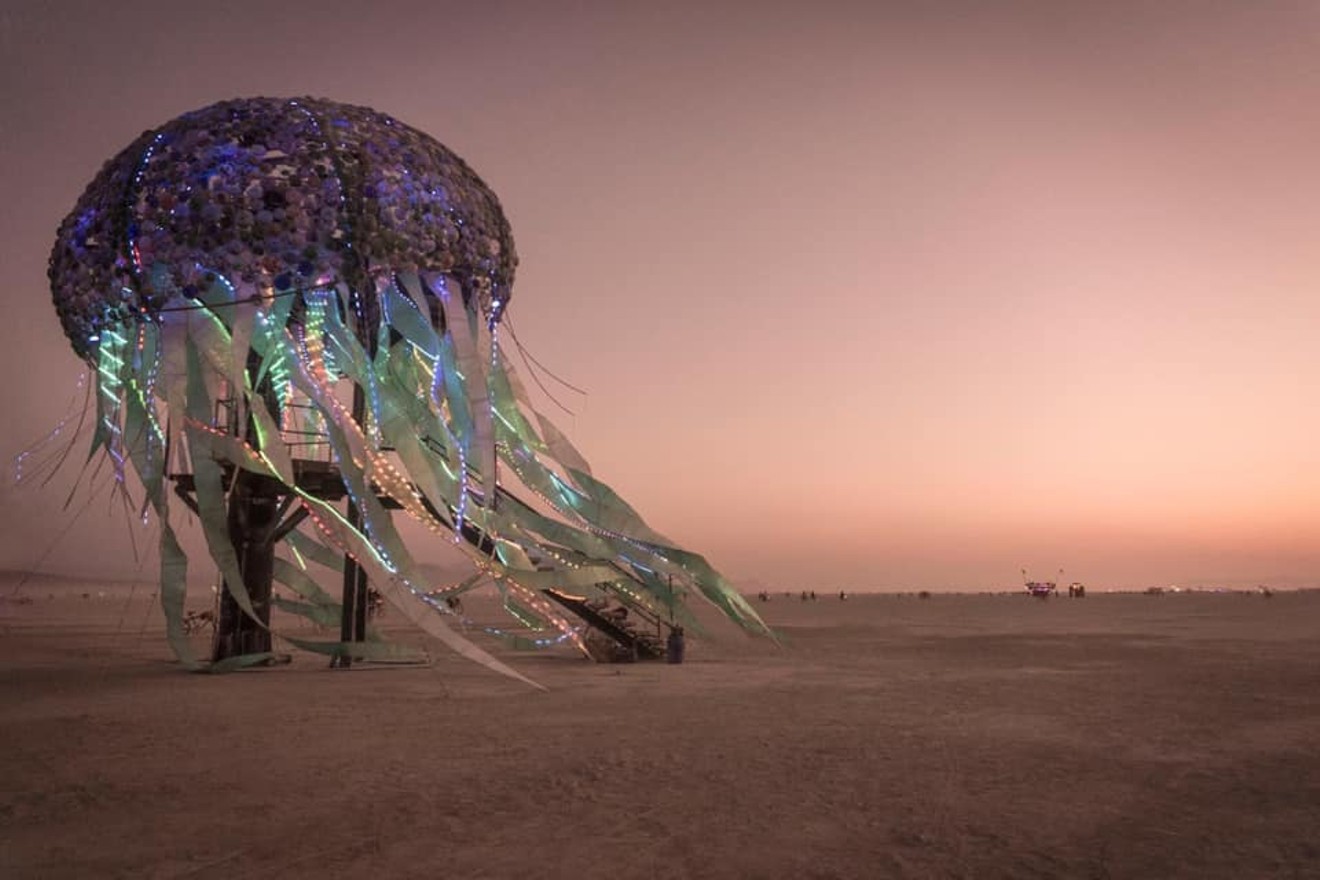The Burning Man experience started during summer solstice 1986, when two friends decided to burn a deconstructed wooden sculpture on a San Francisco beach. It’s grown into an annual convening for participants who create a temporary city in Nevada’s Black Rock Desert, then spend several days sharing large-scale art installations and performances, including many centered around fire. Last year, Burning Man drew about 70,000 people.
Saguaro Man, whose volunteers will be gathering for a work session during Easter weekend, happens on a much smaller scale, yet it’s a significant part of Burning Man culture. They're set for Saguaro Man volunteers, but you can get involved with other burner happenings through the AZ Burners website.
“Saguaro Man is one of the better-known regional events,” according to Ricky Fawley. He’s a longtime burner affiliated with Camp Walter, which has one of the largest Burning Man footprints. “People come from all across the country to participate in Saguaro Man,” he says.
Arizona burners follow 10 principles promulgated by the Burning Man Project, a San Francisco-based nonprofit that’s the nexus of Burning Man culture. They include radical self-expression, immediacy, civic responsibility, and other ideals reflected in Burning Man gatherings.
“It’s an interesting network that runs the gamut in terms of socio-economic status and age,” according to Phoenix artist and burner Kristin Wesley. There’s no master list of local burners, but Wesley notes that about 2,500 people are part of an AZ Burner Facebook group.
Organizers never describe burner events as festivals, by the way. They’re all about participating, instead of being a spectator. And they’re shared communal experiences, rather than entertainment for passive consumption. Some burners form groups called camps, which create theme experiences during events like Saguaro Man.
Burning Man uses a gifting economy, meaning that nothing is for sale during their events. People buy tickets to attend, but after that it’s all about radical self-reliance and leaving no trace. Burners bring along everything they’ll need to survive for several days in the desert, then pack up all their trash and haul it back home after the event.
Saguaro Man works the same way, giving people a chance to experience burner culture without investing the extra time and money needed for a Nevada road trip. “Not everyone can get to Burning Man,” Fawley says.
Burning Man runs from Sunday, August 25, to Monday, September 2, this year. Tickets cost $425 each, compared to just under $100 for Saguaro Man. When Burning Man tickets went on sale Wednesday, April 10, a computer glitch gave frustrated burners a chance to practice being nice instead of nasty.

Part of the Saguaro Man 2019 temple, created by an artist team led by Michael (Oaks) Wright and Meredith Miller.
Tim G.
Whitney goes by Qqtpie with fellow burners, and says everyone who participates gets a name from one or more peers. Sometimes it’s inspired by a personality trait, or something a person says or does. That’s one way burners practice the principle of immediacy, she says.
Other Saguaro Man organizers include Ron Russell (Buddha), Tim G (who prefers using a letter in lieu of a last name, and goes by Serpico), and Kristin Wesley (YoMama). People who frequent the downtown Phoenix art scene have likely seen Wesley’s artwork.
A few years ago, Wesley made 30 giant wooden forms called Friendly Flowers for a Saguaro Man installation. She’s made almost 100 to date, including several installed along Grand Avenue near an anti-Trump billboard that dominates the skyline.
About 800 people have tickets to Saguaro Man this year, which runs from Wednesday, May 1, to Sunday, May 5. Whitney, who describes it as “about three blocks of Burning Man plopped down into the Arizona desert,” is one of dozens of volunteers who’ll be there.
It’s been a decade since Whitney first attended Burning Man, where she felt a connection that still resonates here at home. “I always thought I was a little odd; it turns out I’m not odd at all,” she says. “At Burning Man, I found people who think like me: I felt like I’d known everyone my whole life.”
Russell praises local events like Saguaro Man for giving people a place to practice the 10 principles. “They’re like a sandbox for people to try out these new skills, and create a space where people can be creative and silly and flexible in an adult fashion that’s constructive.”
People attend the events for various reasons, according to Tim G. “At first, the big thing with me was all the art that people produced to take to the big burn,” he says. “But then it was the community that kept me involved.”
Saguaro Man grew out of a smaller Arizona event, which was called Toast from 2003 to 2010. For many years, it took place in Snowflake, situated northeast of Phoenix. This year, it’s moving to a site called Firebase Chaote, located about one hour’s drive east of Tucson near Willcox, where the terrain is similar to that for Burning Man.
Organizers expect more growth in coming years, so they’re having conversations about finding a permanent home, where they can build the infrastructure to accommodate more people and create more large-scale experiences. “Our goal is to have 3,000 people attend Saguaro Man in the future,” Whitney says. “We expect to get our own land in the next year or two.”
For now, it’s all about making Saguaro Man 2019 happen.
Volunteers are attending a work weekend at the site on Saturday, April 20, and Sunday, April 21. And they’re finessing details like where to situate various camps, using a running list of which burners are creating what activities for the event. Glancing at the list, the eclectic nature of Saguaro Man participants is clear.
The Slutt Putt camp is doing a miniature golf course, and the Alchemy camp is creating a tiki lounge. The Cotton Candy camp plans a fashion show, and the Dogville camp is doing a parade for kids and pets. Other Saguaro Man offerings include sunrise Jugallo yoga, painting, belly dancing, a conversation about male psychology, and a naked Olympics competition for the scantily clad.
On the Sunday night, burners will gather around a temple made with recycled pallet wood, where event materials says participants will “hold space for another and honor that which needs to be.” The temple is one of many Burning Man essentials incorporated into regional events.
Saguaro Man is one of Arizona’s main Burning Man-sanctioned events, but it’s not the only one. On Friday, April 19, local burners will open an art exhibition at Alwun House with a free community event called IGNiGHT. Like Saguaro Man, it’ll feature a temple, fire art, fire experiences, and other elements created by burners.
That’s just how Wesley likes it.
“Burning Man is a giant playground,” she says. “We want to bring that sense of play to the masses.”















